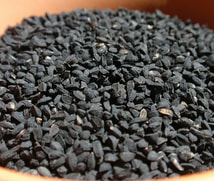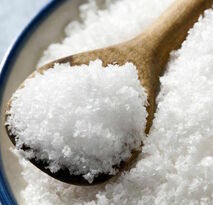
My Big Fat Greek Spice Rack
Following are the spices and herbs no self-respecting Greek would ever be without. If you want to cook like a Greek, you have to stock up like one. Once you have your grocery list ready, check out the stores and websites at the end that carry these items.

This seed is what gives ouzo its distinctive smell, and flavors so many foods in Karpathian cooking. Because the seeds are potent, you only need a small amount to give breads, cakes, and pastries a tasty accent. The preparation we use is: Combine 1/2 teaspoon seeds with ¼ cup water and bring to a boil, then simmer 5 minutes or until aromatic. The strained liquid is then added to recipes.
These seeds also have a medicinal digestive use for easing gas pains in babies (and adults): Bring 1 teaspoon anise seed and 2/3 cup water to a boil, reduce heat and simmer 5 minutes. Strain and cool to warm. Babies love it because it has a natural sweetness, and it makes them feel better fast.

Mahlepi seeds are the tiny (about 1/4 inch) dried pits of wild cherries native to the Eastern Mediterranean and Middle East. Mahlepi is sold as whole seeds and ground, and should be light beige in color (they get dark when they’re old and stale). Whole seeds have a longer shelf life and can be frozen (in a heavy-duty freezer bag) up to two years. When ready to use, the seeds are ground using a mortar and pestle. This beautifully aromatic spice is used to flavor cakes, pastries, and holiday breads. Mahlepi gives tsoureki (Greek Easter bread) its trademark fragrance and fills the kitchen, and house, with its extraordinary sweetness when baking.

Mastiha is the rare crystallized resin that seeps from the bark of the mastic tree (Pistacia lentiscus). The tree, indigenous to the island of Chios, also produces a wild pistachio. The resin, which drips in the shape of teardrops, has been the island’s trademark and largest export from ancient times, and is the main source of income for thousands of families on Chios. The value of the mastic trees on Chios has invoked numerous invasions by other civilizations as well as pirates. Masticate, meaning “to chew,” is derived from the word mastiha, which is actually the word Greeks use for chewing gum, and it is believed that this was the very first gum in history. Mastiha is used in a number of different products, including chewing gum, alcoholic beverages, breads, ice cream, syrups, and sweets. Before adding it to recipes, the crystalized resin beads must be ground into a powder, along with a little sugar from the recipe, using a mortar and pestle. The sugar keeps the mastic from sticking to the surface of the mortar and pestle (which it will do if you try to grind it alone) and allows it to be ground into a fine texture.

These small black seeds are about the size of sesame seeds and look like they could be black sesame but in fact are not sesame at all. They are picked from the Nigella sativa plant grown in Egypt and India. Nigella seeds are a spice as well as a seed, imparting a smoky, oregano-peppery flavor to recipes. The most common use is sprinkling them on breads, kouloures, and breadsticks, alone or combined with sesame. The essential oils in the seeds have antimicrobial agents and can benefit digestion by eliminating parasites.

Amazing food requires high-quality ingredients—fresh vegetables, choice meats, and, yes, sea salt! Sea salt is the only salt used in traditional Greek cooking. Its natural, salt-water flavor is a far cry from the chemical taste of table salt and you will notice the difference! Sea salt also dissolves more easily than table salt when cooking, and is lower in sodium (it’s flaked, so there’s less salt per measure) so it’s a healthier choice as well. Greek sea salt comes in fine, medium, and coarse crystals, is inexpensive, and can be found in Greek/Mediterranean stores, as well as online.

In stick form you can tell that cinnamon is the inner bark of a tree, a tropical evergreen tree to be exact. Both stick and ground versions are used in a wide array of dishes. From a subtle flavoring in meat sauces used in moussaka and pastitsio, to a more prominent taste in sweets like baklava and galaktomboureko, this spice is invaluable in the Greek kouzina. Ancient physicians prescribed cinnamon to improve circulatory health and today’s research suggests that it may reduce blood-sugar levels in diabetics (just ½ teaspoon per day).
RESOURCES:
Mayo Clinic: Diabetes treatment: Can cinnamon lower blood sugar?
Medical News Today: Cinnamon, blood sugar, and diabetes

These dried, unopened flower buds of the tropical evergreen clove tree are a valuable spice worldwide. Clove’s aromatic, peppery flavor lends itself to a number of dishes from sauces and meats to desserts like karithopita (nut cake with syrup) and spoon sweets. For centuries, cloves have been chewed to eliminate bad breath and it’s not surprising that some Greeks always have a small bag they carry with them.

This dark-brown seed from the nutmeg tree is a lighter brown to tan color on the inside and has a warm, spicy-sweet taste. Though you can use it pre-ground, for the most aromatic and flavorful addition to your foods, we suggest you grate it fresh when you need it (you will notice the difference). You’ll find this spice in béchamel sauce (used in moussaka and pastitsio), potato croquettes, syrups, and cakes.

This pea-sized berry of the evergreen pimiento tree seems to embody the flavors of cinnamon, nutmeg, and cloves, hence the name. Sold in dried-berry and ground form, it’s best to grind the berries as needed for the freshest taste. A pinch goes a long way in tomato-based sauces, meats, and Karpathian breads.

This aromatic spice is a member of the ginger family and takes the form of seeds in small pods. Cardamom is sold in seed (to grind for recipes) and finely ground forms. We use it ground in sweets and find this spice to be potent enough to last up to a year. Ancient Greeks and Romans scented their perfumes with cardamom and ancient Egyptians chewed on the seeds to clean their teeth.

This is the only vanilla used in Greek baking because it’s the most flavorful component of the vanilla bean. It’s white in color, looks a bit like confectioners’ sugar, and is made up of tiny crystal flakes. The flavor is super concentrated compared to vanilla extract so you would use a very small amount—a pinch usually does the trick. It imparts a pure vanilla essence to recipes, without the aftertaste of alcohol (from the extract), making it perfect for custards, cakes, cookies, and breads. It’s a bit pricey but remember that a little goes a very long way, and it will make your Greek desserts taste like heaven, the way they should!
Ready, set, shop!
SOURCES (for purchase)
Mediterranean Foods (2 locations)
22-78 35th Street
Astoria, NY 11105
718-721-0266
30-12 34th Street
Astoria, NY 11103
718-728-6166
Sahadi’s, 187 Atlantic Avenue, Brooklyn, NY
Titan Foods, 25-56 31st Street, Astoria, NY
GreekShops.com
Greek Market
Parthenon Foods
We hope you enjoyed our journey down the spice aisle. Stay tuned for upcoming segments on uniquely Greek ingredients!
Sign up for our e-newsletter (if you haven’t already) and stay connected on social media for cooking tips and recipes, as well as for all Kukla's Kouzina updates and news.
Thanks for following us and we’ll see you next Monday!
Until then~
Kali orexi! Good appetite!
Kelly
Web design by Kelly Salonica Staikopoulos








